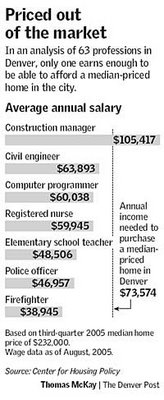The article quotes Donald Shoup, a professor of urban planning at the University of California at Los Angeles and the author of The High Cost of Free Parking, "In the United States, housing is expensive and parking is cheap. We’ve got it the wrong way around.”
Although condominiums without parking are common in Manhattan and the downtowns of a few other East Coast cities, they are the exception to the rule in most of the country. In fact, almost all local governments require developers to provide a minimum number of parking spaces for each unit — and to fold the cost of the space into the housing price.
The exact regulations, which are intended to prevent clogged streets and provide sufficient parking, vary by city. Houston’s code requires a minimum of 1.33 parking spaces for a one-bedroom and 2 spaces for a three-bedroom. Downtown Los Angeles mandates 2.25 parking spaces per unit, regardless of size.
Today, city planners around the country are trying to change or eliminate these standards, opting to promote mass transit and find a way to lower housing costs.
Read the full aricle in the New York Times . . .


 While the western portion of Garfield County is booming with oil and gas development, and the associated environmental impacts, the eastern end of the county is looking in a different direction for energy production.
While the western portion of Garfield County is booming with oil and gas development, and the associated environmental impacts, the eastern end of the county is looking in a different direction for energy production. Trees in an arid environment such as Denver cannot be taken for granted. But it is not only rain fall that determines the type and number of trees - commuity income plays a factor as well.
Trees in an arid environment such as Denver cannot be taken for granted. But it is not only rain fall that determines the type and number of trees - commuity income plays a factor as well.
 When Michael Shuman presented at
When Michael Shuman presented at  Medicare and Medicaid programs paid for more than half of all patient days at Colorado hospitals in 2005, fresh evidence that taxpayers are increasingly picking up the tab for health care at hospitals.
Medicare and Medicaid programs paid for more than half of all patient days at Colorado hospitals in 2005, fresh evidence that taxpayers are increasingly picking up the tab for health care at hospitals.
 Carbondale town trustees
Carbondale town trustees

 We all know a place in our community where tree roots are busting trough a sidewalk or paved trail. What to do? Hack the tree roots and risk killing the tree? Move the side walk or trail?
We all know a place in our community where tree roots are busting trough a sidewalk or paved trail. What to do? Hack the tree roots and risk killing the tree? Move the side walk or trail? The Eagle County Commissioners voted to put a early-childhood tax proposal on the fall ballot. If approved, the tax would raise $2 to $3 million per year for projects aimed at “early childhood,” or kids between birth and six years old.
The Eagle County Commissioners voted to put a early-childhood tax proposal on the fall ballot. If approved, the tax would raise $2 to $3 million per year for projects aimed at “early childhood,” or kids between birth and six years old.
 First is was the Brits, now its those people with the funny accents up in the Great White North that are healthier than we Americans.
First is was the Brits, now its those people with the funny accents up in the Great White North that are healthier than we Americans.  Hot off the presses is a study in the
Hot off the presses is a study in the  Aspen began its effort to get buses out of town faster by testing the new bus lane on Main Street heading out of town. The city will restricting parking along Main Street from 3-6 p.m., Monday through Friday, to create the new bus lane.
Aspen began its effort to get buses out of town faster by testing the new bus lane on Main Street heading out of town. The city will restricting parking along Main Street from 3-6 p.m., Monday through Friday, to create the new bus lane. Western author Wallace Stegner wrote about the goal of creating a society to match the scenery of the region. To get there, the West will have to formulate a vision to match its views, an expert in regional planning and conservation told a Glenwood Springs audience Friday. "We need to articulate a broad vision, a bold vision for a more sustainable, more benign society,"
Western author Wallace Stegner wrote about the goal of creating a society to match the scenery of the region. To get there, the West will have to formulate a vision to match its views, an expert in regional planning and conservation told a Glenwood Springs audience Friday. "We need to articulate a broad vision, a bold vision for a more sustainable, more benign society," 














